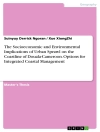Table of Content
A taxonomic review of the genus Phaeocystis.- Methods used to reveal genetic diversity in the colony-forming prymnesiophytes Phaeocystis antarctica, P. globosa and P. pouchetii—preliminary results.- The life cycle of Phaeocystis: state of knowledge and presumptive role in ecology.- Phaeocystis colony distribution in the North Atlantic Ocean since 1948, and interpretation of long-term changes in the Phaeocystis hotspot in the North Sea.- Photosynthetic responses in Phaeocystis antarctica towards varying light and iron conditions.- Effects of iron concentration on pigment composition in Phaeocystis antarctica grown at low irradiance.- Evidence for high iron requirements of colonial Phaeocystis antarctica at low irradiance.- The carbohydrates of Phaeocystis and their degradation in the microbial food web.- The role of iron in the bacterial degradation of organic matter derived from Phaeocystis antarctica.- The colonization of two Phaeocystis species (Prymnesiophyceae) by pennate diatoms and other protists: a significant contribution to colony biomass.- Zooplankton grazing on Phaeocystis: a quantitative review and future challenges.- The influence of Phaeocystis globosa on microscale spatial patterns of chlorophyll a and bulk-phase seawater viscosity.- Haemolytic activity of live Phaeocystis pouchetii during mesocosm blooms.- Phaeocystis and its interaction with viruses.- Does Phaeocystis spp. contribute significantly to vertical export of organic carbon?.- Vernal sedimentation trends in north Norwegian fjords: temporary anomaly in 234Th particulate fluxes related to Phaeocystis pouchetii proliferation.- Environmental constraints on the production and removal of the climatically active gas dimethylsulphide (DMS) and implications for ecosystem modelling.- Variability inabundance and fluxes of dimethyl sulphide in the Indian Ocean.- Gaining integrated understanding of Phaeocystis spp. (Prymnesiophyceae) through model-driven laboratory and mesocosm studies.- Current understanding of Phaeocystis ecology and biogeochemistry, and perspectives for future research.












